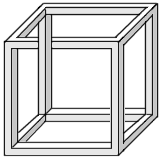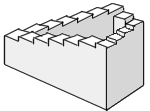




While discussing the concepts of infinity and belief late one night at the Coffeehouse, our man Charles was reminded of a wonderful book written back in 1962 by the philosopher Jaakko Hintikka: Knowledge and Belief, in which he develops a working logic of these two notions. Among the semantics developed and argued is the plausible conditional 'If one believes some proposition, p, then one believes that one believes that p.' The seemingly obvious idea is that one can't believe that something is the case without at least believing that one believes it. 'Charles believes that Maggie is at the store, but Charles doesn't believe that he believes this' does appear to be plainly false, to be sure, if not bordering on an inconsistency. Letting the Hintikka logical notation 'Bap' be read as 'a believes that p,' the above semantic implication is, thus:
1. Bap > BaBap
So far, so good, you say. Upon hearing this, dear Maggie (who's not at the store, obviously!) jumped into the Coffeehouse discussion and added a Zenoesque comment and challenge:
"Hold on, Charles. If we let 'Bap' be the proposition believed by a above in the consequent condition, then, according to 1, we can derive that
2. BaBap > BaBaBap,
and hence that
3. BaBaBap > BaBaBaBap
and so on ad infinitum! So what you and Hintikka are saying is that if one has any belief at all, then one has an infinite number of beliefs? Charles, this sounds crazy! Am I missing something? What sounded like an obvious truism seems to entail that believers are like Zeno's racers...you can't move unless you move forever! Yikes!"
Is Maggie correct? Does the maxim that one believes what one believes entail that one has an infinite number of beliefs? Is this a problem? Help!
As faithful logical patrons, can you shed some light on this challenge? ....Ron Barnette, Zeno's Proprietor
Please submit your reasoned answer here:
For your continued enjoyment, I thought I'd keep these so-called Impossible Objects on here, as you contemplate the new challenge. I continually receive positive comments from many loyal Coffeehouse patrons. If you locate other good ones, please let me know. Enjoy!...Ron Barnette
I credit Jim Loy for these marvelous example of so-called impossible objects, which should amuse you faithful Zeno's patrons, who appreciate thought-provoking stimulation.
 |
1. Asymmetric crate. An M. C. Escher creation, I surmise | |
 |
2. The Penrose staircase: Often drawn by M. C. Escher. Clockwise is downstairs forever. | |
 |
3. The tribar: Another impossible object by R. Penrose. It's hard to know how to color it, as the interior becomes the exterior. | |
 |
4. The Penrose triangle: Another famous impossible object by R. Penrose. This is sometimes called a tribar (see #3, above). | |
 |
5. An ambiguous ring...What is the outside? The inside? |